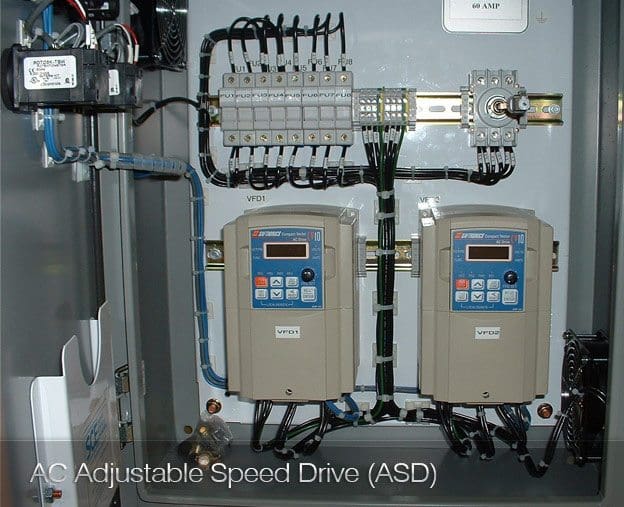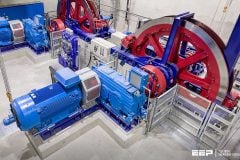Variable Speed Control
The simplest and least expensive way to control the speed of a process or piece of equipment is to operate all the equipment at full speed.

Many applications require the speed of a process or piece of equipment to be varied. Prior to the advent of the AC Adjustable Speed Drive, many technologies have been used, although each has its inherent advantages and disadvantages.
There are few types of Variable Speed Control:
- Control Valves, Dampers and Vanes
- Fossil Fuel Engines
- Eddy Current Clutches
- Hydraulic Couplings
- Variable Pitch Sheaves
- DC Solid State Controllers
- AD Adjustable Speed Drives (ASDs)
AC Adjustable Speed Drive (ASD)
AC Adjustable Speed Drive (ASD) have become very popular variable speed control devices used in industrial, commercial and some residential applications.
These devices have been available for about 20 years and have a wide range of applications ranging from single motor driven pumps, fans and compressors, to highly sophisticated multi-drive machines. They operate by varying the frequency of the AC voltage supplied to the motor using solid state electronic devices.
These systems are fairly expensive but provide a higher degree of control over the operation and in many cases, reduce the energy use enough to a least offset if not more than pay for the increased cost.
ASDs allow precise speed control of a standard induction motor and can result in significant energy savings and improved process control in many applications. ASD can also control the speed of a standard squirrel cage NEMA type B induction motor and they are suitable not only for new applications, but also for retrofit on existing motors.
Adjustable Speed Drive (ASD) Function
AC Adjustable Speed Drives can be thought of as electrical control devices that change the operating speed of a motor. ASDs are able to vary the operating speed of the motor by changing the electrical frequency input to the motor.
The speed an AC induction motor operates is given by the following equation:
Where:
Frequency = Electrical frequency of the power supply in Hz.
Number of poles = Number of electrical poles in the motor stator.
Changing the Motor Speed
Motors speed can be changed by altering the electrical frequency, the number of poles, or both. Motor speed can be also changed by altering the number of poles in a motor from 4 to 2:
4 pole motor operating on 60 hertz = 1800 rpm.
2 pole motor operating on 60 hertz = 3600 rpm.
We really CHANGED speed rather than varied speed!
Motor speed can be changed by altering the frequency of the electrical supply:
4 pole motor operating on 50 hertz = 1500 rpm.
4 pole motor operating on 40 hertz = 1200 rpm.
By varying frequency, we can adjust the speed over a wide range or vary the speed precisely using precise changes in the electrical frequency input to the motor.
Power and Torque
ASDs actually control both frequency and voltage simultaneously to maintain a constant volts/hertz ratio which keeps current flow similar to full speed conditions. This allows the motor to draw full current at any speed and produce full torque as motor speed changes.
What happens to the Horsepower when we lower the speed and torque using frequency?
Reduced Horsepower = Reduced Energy Use = Energy Savings!!
What About INCREASING Speed?
Some specially designed motors meant for use with ASDs are designed to operate at higher than normal speeds at frequencies above 60 hertz.
- Was the motor or the load it drives designed to operate at these increased speeds?
Many motors and devices were not mechanically balanced to operate at increased speeds and will create vibration, mechanical and safety problems.
. - ASD’s are not capable of increasing voltage so as frequency increases above 60 hertz, the torque produced starts to decrease.
In order to maintain a constant horsepower output to drive our load, if speed is increased, torque must decrease!
Only the manufacturer can help determine when this occurs.
ASD Advantages and Disadvantages
Adjustable Speed Drives have a number of advantages and disadvantages compared to other types of variable speed controls including the following:
Advantages
– Energy Savings
– Improved Process Control
– Reduced Voltage Starting
– Lower System Maintenance
– Bypass Capability
– Multi-motor Control
Disadvantages
– Initial Cost
– Motor Heating at low Speeds
– Maintenance
– Output Harmonics
– Induced Power Line Harmonics
Adjustable Speed Drives can be used to save significant amounts of energy in process operations compared to traditional control methods where the load or speed of the operation varies.
AC Adjustable Speed Drives are among the most efficient types of speed control when used on axial (variable torque) loads like centrifugal fans, pumps and compressors. As the motor reduces the operating speed of the fan, pump or compressor the horsepower required to operate the system is greatly reduced.
Resource: PAControl – AC Adjustable Speed Drives (ASDs)











I want to convert a 1500 kg LDV to electric motor, without gearbox, 950 rpm, 500V.
Maximum speed required 20 – 30 km / h. VSD. With lithium ion batteries. Can it work. What do I need? Where can I buy the things I will need? Please help. Regards, Kobus
I like your site a lot. I clicked on the article about VFDs ,yes that is what they are called, Variable Frequency Drives. I don’t know what planet they call them ASDs but here on Earth we call them VFDs. Once again for those of us confused by all these acronyms. VFD variable frequency drive. It does exactly what it sounds like it would do. Good day gentlemen.
Could you explain about using of electric motor in electric train with dc power supply of 1500 VDC?
What kind of control system for speed and braking..
Thanks
which motor with vfd work better,2-pole or 4-pole ( 6.6 kv) ?
thanks
I’m from the US. I’m not familiar with either a 2 or 4 pole AC motor. I’d be cautious of advice from anyone that isn’t familiar with three phase AC electric. Industry standard here are 3 phase ac electric motors. Maybe it’s different in other countries but i don’t think so. We even feed our VFDs with single phase and they create three phase internally to power the motor. Feed your VFD a AC voltage. It then converts the voltage to DC (600v dc bus) it then uses this DC power to create it’s own AC with a range of frequency. lower for slower speeds and higher for faster. It’s brilliant really.
what is the maximum % of frequency that you can apply to an induction motor so us not to damage the winding of the motor?
You really would want to contact the motor manufacturer to be certain. The nameplate usually gives you a pretty good idea of what hz that motor is built to handle